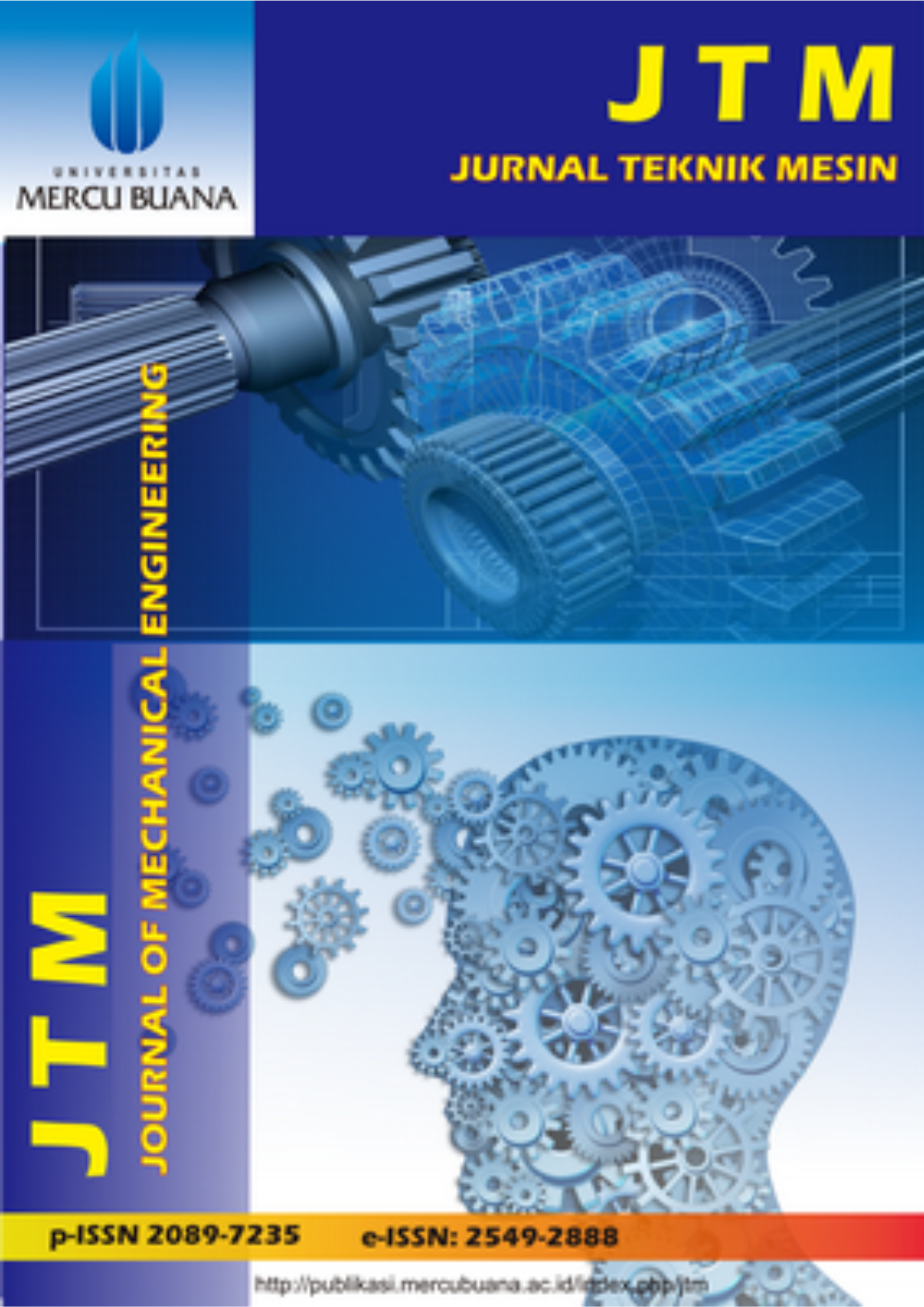ANALYSIS OF THE EFFECT OF PENSTOCK DIAMETER ON HYDROCOIL TURBINE PERFORMANCE IN SUKAJAYA VILLAGE, LEMBANG DISTRICT, WEST JAVA
Abstract
The turbine used in this study is a reaction turbine called hydrocoil turbine. In hydrocoil turbines require penstock pipe components to support turbine performance, the size of the penstock pipe has its own potential. Errors in determining the diameter of the penstock can affect the performance of hydrocoil turbines. The purpose of this study is to perform penstock comparison using ansys with a diameter of 6 inches, 8 inches and 10 inches and determine the diameter of the penstock to get the best hydrocoil turbine performance. This study was conducted using Computational fluid dynamics (CFD) method which includes torque, turbine power, and efficiency, the results of the analysis of the calculation of the highest torque value obtained by the 10-inch penstock at 150 rpm rotation of 398.51 Nm, and the torque value obtained by the 8-inch penstock at 150 rpm rotation of 282.47 Nm, the lowest torque value obtained by the 6-inch penstock at 950 rpm rotation of 51,061 Nm. Then the highest power value obtained by the 10-inch penstock at 950 rpm rotation of 27279.53 Watts and the power obtained by the 8-inch penstock at 950 rpm rotation of 21861.41 Watts, the lowest power obtained by the 6-inch penstock at 950 rpm rotation of 5077.16 Watts. So that the highest efficiency value obtained by 10-inch penstock at 950 rpm rotation of 90.58% and the efficiency value obtained by 8-inch penstock at 950 rpm rotation of 72.59 %, the lowest efficiency value obtained by 6-inch penstock at 950 rpm rotation of 16.85 %. It can be concluded from the values already obtained, penstock with a diameter of 10 inches has the highest value to get the best turbine performance, followed by penstock diameter of 8 inches has the highest value Number 2 and penstock with a size of 6 inches has the lowest value, proven by the speed varied according to the diameter of the penstock and constant discharge indicates that the larger the diameter of the penstock will produce the best turbine performance.
Keywords
Full Text:
PDFReferences
A. W. Biantoro, Iskendar, Subekti, and N. H. bin M. Noor, “The Effects of Water Debit and Number of Blades on the Power Generated of Prototype Turbines Propeller as Renewable Electricity,” J. Rekayasa Mesin, vol. 12, no. 1, pp. 203–215, 2021.
B. Novianto, “Rancang Bangun Low Head Turbin Piko Hidro,” J. Saints dan Teknol., vol. 10, no. 01, 2020, [Online]. Available: https://unsada.e-journal.id/jst/article/view/79.
I. Hanggara and H. Irvani, “Potensi PLTMH (Pembangkit Listrik Tenaga Mikro Hidro) Di Kecamatan Ngantang Kabupaten Malang Jawa Timur,” J. Reka Buana, vol. 2, no. (2), pp. 149–155, 2017.
A. Akbar, Taupan, “Analisa Pengaruh Ketinggian Dan Debit Air Terhadap Output Energi Listrik Yang Dihasilkan Pada Pembangkit Mikrohidro (PLTMH) Desa Girikerto,” Tek. Elektri Univ. Islam Indones., 2018.
A. A. Luthfie, “Analisis Pengaruh Perubahan Pipa Siphon Terhadap Performasi Turbin Hydro coil Dengan Menggunakan Metode (CFD),” J. Tek. Mesin, vol. Vol. 06, no. No. 1, p. 41, 2017, [Online]. Available: https://publikasi.mercubuana.ac.id/index.php/jtm/article/view/1336.
A. D. Pratama, E. W. Hidayah, and U. A. Retno, “Desain Determinasi Optimum Penstock Untuk Pembangkit Listrik MikroHidro Di Sungai Poreng, Jember,” J. Tek. Pengair., vol. Vol 12, no. (1), pp. 71–80, 2021.
M. Syukri, “Pembangkit Listrik Tenaga Piko Hydro Dengan Menggunakan Turbin Ulir,” J. Komputer,Informasi Teknol. dan Elektro, vol. Vol 2, no. No 1, 2017, [Online]. Available: http://www.jurnal.unsyiah.ac.id/kitektro/article/view/6757.
D. Marsudi, “Pembangkit Energi Listrik,” vol. vol 7, no. no1, pp. 4–31, 2016.
A. Aprilliyanto, Indarto, and Prajitno, “Design Of A Prototype Hydro Coil Turbine Applied As Micro Hydro Solution,” ASEAN J. Syst. Eng., vol. 1, no. 2, pp. 72–76, 2013, [Online]. Available: https://core.ac.uk/download/pdf/291675957.pdf.
N. Ma, ali, “Perencanaan Pembangkit Listrik Tenaga Mikro Hidro (PLTMH) Kepung Kabupaten Kediri,” 2017.
S. Maulana, “Pemanfaatan Computational Fluid Dynamics (CFD) Dalam Strategi Penelitian Simulasi MOD,” J. Educ. Build., vol. 2, no. 2, pp. 10–13, 2016.
J. Cengel, Yunus A Cimbala, Fluid Mechanics: Fundamental And Application. 2006.
DOI: http://dx.doi.org/10.22441/jtm.v14i3.18244
Refbacks
- There are currently no refbacks.
Copyright (c) 2025 Jurnal Teknik Mesin
Jurnal Teknik Mesin (JTM)
Program Studi Teknik Mesin, Fakultas Teknik, Universitas Mercu Buana
Jl. Meruya Selatan No. 01, Kembangan, Jakarta Barat 11650, Indonesia
Email: [email protected]
Telp.: 021-5840815/ 021-5840816 (Hunting)
Fax.: 021-5871335
JTM is indexed by the following abstracting and indexing services:

This work is licensed under a Creative Commons Attribution-NonCommercial 4.0 International License.






.png)







_(486_x_90_px)_(486_x_190_px)_(486_x_190_px)_(4).png)
_(486_x_90_px)_(486_x_190_px)_(486_x_190_px)_(5).png)
2.png)
.png)